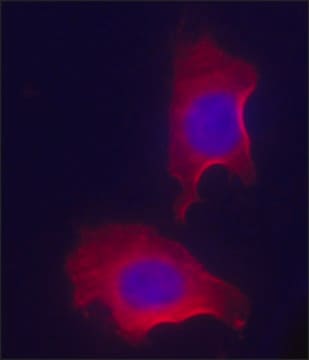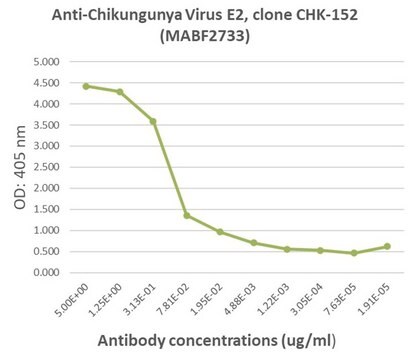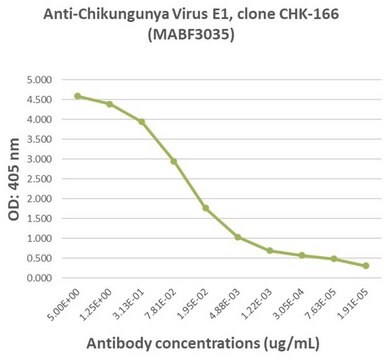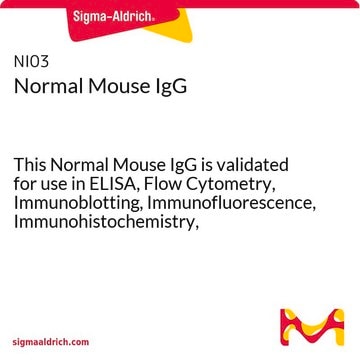MABF2051
Anti-Chikungunya virus Antibody, clone 6A11
clone 6A11, from mouse
Synonim(y):
CHIKV, E1 Protein
Zaloguj sięWyświetlanie cen organizacyjnych i kontraktowych
About This Item
Kod UNSPSC:
12352203
eCl@ss:
32160702
NACRES:
NA.41
Polecane produkty
pochodzenie biologiczne
mouse
Poziom jakości
forma przeciwciała
purified immunoglobulin
rodzaj przeciwciała
primary antibodies
klon
6A11, monoclonal
reaktywność gatunkowa
virus
opakowanie
antibody small pack of 25 μg
metody
immunocytochemistry: suitable
western blot: suitable
izotyp
IgG2bκ
docelowa modyfikacja potranslacyjna
unmodified
Opis ogólny
Chikungunya virus (CHIKV) that causes distinctive polyarthritis or polyarthralgia with clinical features such as fever, maculopapular rash, and myalgia is transmitted by Aedes spp of mosquitoes. Immune compromised individuals may face serious complications, including encephalitis and mortality. CHIKV genome contains a single-stranded positive-sense RNA that encodes four non-structural proteins known as nsP1, nsP2, nsP3, and nsP4 and also five structural proteins that include a capsid protein, three envelope glycoproteins known as (E1, E2, and E3, and a small molecule known as 6K. The mature alphavirus particles express E1 and E2 heterodimers that form 80 trimeric spikes on the surface of the virion. The ectodomain E1 protein consists of three domains known as D1, DII, and DIII. The DIII domain is an immunoglobulin-like domain connected to D1 and DII by a flexible linker. Both E1 and E2 proteins are responsible for virus entry into host cells. The E2 glycoprotein interacts with a cellular receptor, resulting in the virus internalization and the E1 glycoprotein mediates virus fusion to host cell under low pH conditions. Following the fusion of the viral envelope with the endosomal membrane, the viral genomic RNA is released into the cytoplasm and starts replicating. (Ref.: Marsinoul, P., et al. (2014). Virology 464-465; 111-117; Lam, S., et al. (2015). mAbs 7(6), 1178-1194).
Specyficzność
Clone 6A11 specifically detects Chikungunya virus in infected cells.
Immunogen
CH122508 strain of Chikungunya virus.
Zastosowanie
Anti-Chikungunya virus, clone 6A11, Cat. No. MABF2051 is a mouse monoclonal antibody that detects E1 protein of Chikungunya virus (CHIKV) and has been tested for use in Immunocytochemistry and Western Blotting.
Western Blotting Analysis: A 1:100 dilution from a representative lot detected Chikungunya virus in BHK cells infected with CHIKV (Courtesy of an outside independent laboratory).
Immunocytochemistry Analysis: A representative lot detected Chikungunya virus in BHK cells infected with CHIKV (Courtesy of an outside independent laboratory).
Immunocytochemistry Analysis: A representative lot detected Chikungunya virus in BHK cells infected with CHIKV (Courtesy of an outside independent laboratory).
Jakość
Isotype testing: Identity Confirmation by Isotyping Test.
Isotyping Analysis: The identity of this monoclonal antibody is confirmed by isotyping test to be mouse IgG2b .
Isotyping Analysis: The identity of this monoclonal antibody is confirmed by isotyping test to be mouse IgG2b .
Opis wartości docelowych
~9.17 kDa calculated for E1 protein. Uncharacterized bands may be observed in some lysate(s).
Postać fizyczna
Format: Purified
Inne uwagi
Concentration: Please refer to lot specific datasheet.
This page may contain text that has been machine translated.
Not finding the right product?
Try our Narzędzie selektora produktów.
Certyfikaty analizy (CoA)
Poszukaj Certyfikaty analizy (CoA), wpisując numer partii/serii produktów. Numery serii i partii można znaleźć na etykiecie produktu po słowach „seria” lub „partia”.
Masz już ten produkt?
Dokumenty związane z niedawno zakupionymi produktami zostały zamieszczone w Bibliotece dokumentów.
L G Webb et al.
PLoS pathogens, 16(10), e1008999-e1008999 (2020-10-16)
Chikungunya virus (CHIKV) is a mosquito-borne alphavirus known to cause epidemics resulting in predominantly symptomatic infections, which in rare cases cause long term debilitating arthritis and arthralgia. Significant progress has been made in understanding the roles of canonical RNA sensing
Nasz zespół naukowców ma doświadczenie we wszystkich obszarach badań, w tym w naukach przyrodniczych, materiałoznawstwie, syntezie chemicznej, chromatografii, analityce i wielu innych dziedzinach.
Skontaktuj się z zespołem ds. pomocy technicznej



![Refractive index standard traceable to NIST, traceable to PTB, [α]/D 60°, Brix CERTIPUR®](/deepweb/assets/sigmaaldrich/product/images/137/112/c7ee9f1e-5b1a-475f-9853-3595c8466217/640/c7ee9f1e-5b1a-475f-9853-3595c8466217.jpg)




